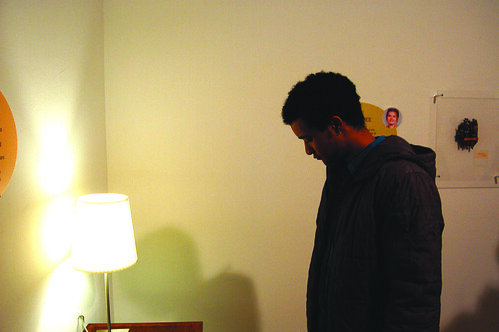Check out The Temple News’ exclusive video coverage as well as the print edition of the article.
Video by Saba Aregai and Luis Rodriguez
Kevin Henson, a senior neuroscience major, was dragged along to the opening of the First Person Museum at the Painted Bride Art Center Friday, Nov. 5. Upon entering the museum – which features everyday items of particular significance to members of various

communities within Philadelphia – Henson wasn’t interested in art or curation and said he found it difficult to connect to the initiatives of the organized displays.
Within three steps inside the museum, Henson made a connection.
“Hey, that’s my Aunt Amy!” Henson said, pointing to a panel that displayed a quote from Amy Henson and her photograph, hanging above a birth certificate within a small display case.
“This is her birth certificate from Germany,” he said.
The exhibition focuses on material culture and artifacts, begging the question of how individuals give value to objects through experiences and stories they share.
“Amy’s birth certificate,” tattered and worn from age, sat in its case on an average nightstand between two chairs that almost every attendee of the opening hesitated to sit in, unsure whether they were artifacts themselves. In that instant, Henson connected to one of the missions of the First Person Museum – revealing relationships through common objects between persons and within history.
But viewers don’t need to be related to a participant to understand the First Person Arts Program’s message within the experimental First Person Museum. From self-drawn maps to dolls and clothing, the display of ordinary objects in the exhibition evokes questions about relationships, stories and histories an individual has with one object.
The items are displayed in a way that reflects an average home, which further emphasizes the overarching theme of personal connection.
Created as an experimental museum by the First Person Arts Program, the museum is part of the program’s First Person Festival of Memoir and Documentary Art. In its ninth year, the festival features slam story and poetry sessions, theater performances and discussions focused on life being shared through artistic expression.
Executive Director and Founder of the First Person Arts Program Vicki Solot described the decision-making process for which items are showcased.
“We have numerous story circles where people come, share their objects and their stories associated with these objects,” Solot said. “Over time, these people decided if they wanted to stay in touch with us and be involved with this exhibition. Who you see in this exhibition are those who decided to continue with the project.”
Solot added that the project was ongoing, and could involve anyone, even outside the story circles headed by the programs like Art Sanctuary and the Norris Square Neighborhood Project.
“You can go onto our online gallery and submit your story,” she said.
The opening of the First Person Museum coincided with the city’s monthly First Friday celebration, which brought Henson to the scene. But Henson would not be the only Temple student who attended the museum opening or the only student with strong connections to the exhibition.
Among those present at the opening included a class of Temple graduate students from Seth Bruggeman’s Studies in American Material Culture class.
Many of Bruggerman’s students were involved in the creation of the exhibition’s panels. Each student was given a specific object from the display to research from a historical perspective. Throughout their research, First Person Arts involvement and historical panel creation, the students blogged about their experiences online.
Offered by Temple’s history department, the class was filled with students pursuing their doctorates in the same discipline, with the exception of an art history student and an archaeology graduate, who were also enrolled in the class. The students’ interests in taking the course ranged from interest in public history, communication, art and archival work.
“I took the course because I have an interest in public history and the use of objects to shape historical meaning,” said Patrick Grossi, a second-year history graduate student. “It’s fun to think about the value individuals place on common objects in their possession.”
Grossi’s object was “Zhaoxi’s map,” a map handwritten by a Chinatown resident. Using the map as a launching point, Grossi wrote a brief historical panel about mapmaking and how maps are essential in helping shape conceptions of urban space, reflecting the space not only directionally, but culturally as well.
“An exhibit like this can encourage visitors to think about the value distinct cultures place on objects in a particular historical moment and how that evaluation can change over time,” Grossi said.
While the students constantly worked with the historical concepts they had to introduce through their assigned objects, they didn’t see their objects in person until the opening night.
Lynette Mattson, a second-year graduate student in the history department, was assigned “Yari’s baby clothes” for her exhibition panel. For the First Person Museum opening, the clothes were placed in a case created using a half-open dresser drawer, presenting the pink-and-white stripes of a baby’s hat and onesie.
Mattson’s panel addressed the history of infant clothing and its relationship to the mother.
“This is very moving,” Mattson said. “All I got to see was this picture of the clothing, and this picture of this mother with her baby. To see everything together and the clothing in person is amazing.”
Nicole Welk can be reached at nicole.welk@temple.edu.



Be the first to comment